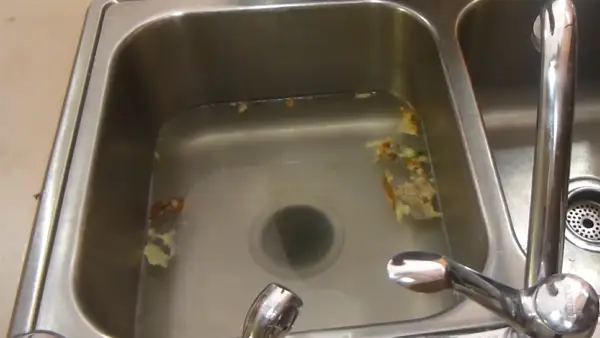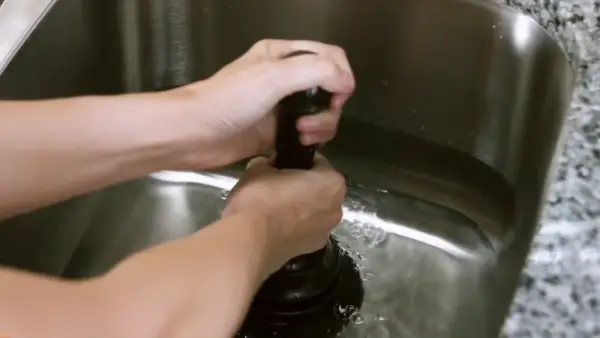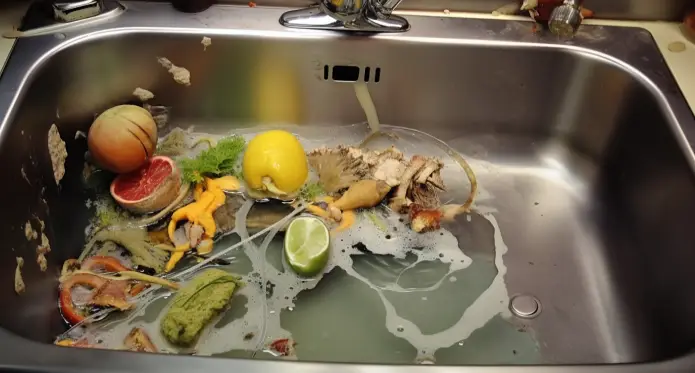Last Updated on November 14, 2023
A clogged kitchen sink is a frustrating and inconvenient problem, especially when it involves garbage disposal. In this case, if your sink won’t drain without the garbage disposal running, it clearly indicates a blockage or issue that needs attention.
You can employ several methods to unclog your kitchen sink and restore it to full functionality. Cleaning the P-trap and dishwasher outlet hose can be a good solution. Plunging the drain is also a good idea, but not the drain snake.
This article will assist you in unclogging your kitchen sink with a sink disposal. So, let’s tackle this problem head-on and get your sink draining properly again.
Can’t Drain Your Sink Unless Turn The Garbage Disposal On: Follow Unclogging Methods

Waste disposal is a complicated kitchen sink system requiring regular maintenance and cleaning. When it is not working properly, it can cause various problems in your kitchen, including the inability to drain properly. Here are some methods you can use to unclog your kitchen sink:
- Method 01: Check and clean the p-trap
- Method 02: Check the dishwasher outlet hose
- Method 03: Inspect the drain with a flashlight
- Method 04: Plunge the sink drain
- Method 05: Use baking soda and vinegar
- Method 06: Professional help
Method 01: Check and Clean the P-Trap
You can start by removing the P-trap under the sink to check for any clogs or debris. The P-trap is the u-shaped pipe beneath the sink connecting to the drain. Before beginning, place a bucket or towel underneath to catch any water or debris that may spill out.
Use a wrench or pliers to loosen the slip nuts on both ends of the P-trap. Once the nuts have been loosen, carefully remove the P-trap attached to the drain and the pipe leading to the waste disposal.
Inspect the P-trap for any clogs or blockages. If you find any debris, clean it with a wire brush or rinse it with water. Once the P-trap is clear, reattach it to the drain and the pipe, ensuring the slip nuts are tightened securely.
Method 02: Check the Dishwasher Outlet Hose
If you suspect a clog in the dishwasher outlet hose, disconnect it from the disposal and inspect for blockages. Start by turning off the power to the disposal and locating the hose. Carefully detach it and check for any debris or obstructions.
If you find any blockages, remove them and clean the hose thoroughly before reattaching it securely. Once the hose is back in place, turn on the disposal’s power and test the sink’s drainage.
Method 03: Inspect the Drain With a Flashlight
Check the drain for any visible debris or obstructions with a flashlight so you can unclog your kitchen sink with a garbage disposal. This method will identify items outside the sink to not flush aside unless the rubbish disposal is turned on.
Put the flashlight down the drain and look for any utensils or large chunks of debris that may be blocking the water flow. If you spot any, use tongs or pliers to carefully remove them, ensuring you don’t push the clog further down the drain.
Method 04: Plunge the Sink Drain
You can use a plunger to unclog your kitchen sink drain when the garbage disposal is causing the problem.
To start, create a tight seal around the drain with the plunger and pump it vigorously to generate suction. This action will help dislodge any minor clogs that may be present. If the clog persists, repeat the plunging process a few times to ensure maximum effectiveness.
Once you have cleared the clog, pour a pot of hot water down the drain. This will help to clear any remaining debris further and ensure proper drainage.
Method 05: Use Baking Soda and Vinegar
Mix equal parts of baking soda and white vinegar to effectively dissolve organic clogs in your kitchen sink drain caused by the garbage disposal. Let the mixture sit for about 15 minutes to allow it to work its magic.
The chemical reaction between the two ingredients will create a foaming action that helps break down the organic matter causing the clog. Then, flush the drain with boiling water to clear away any remaining debris.
Method 06: Professional Help
If all the previous methods haven’t worked, consider hiring a professional plumber to help unclog your kitchen sink with a waste disposal.
A licensed plumber has the expertise and tools to tackle more complex plumbing issues. They can thoroughly inspect your sink and garbage disposal system to identify the root cause of the problem.
What to Avoid When Unclogging a Kitchen Sink With a Garbage Disposal?

Unclogging a kitchen sink with a garbage disposer, you should avoid a few things.
No 01: Avoiding Drain Snakes
You should always avoid using drain snakes to unclog your kitchen sink with a garbage disposer to prevent potential damage to the pipes.
The rotating motion of the snake can cause damage to the pipes, especially the ones connected to the rubbish disposal unit. The sharp edges of the snake can scratch or puncture the pipes, creating leaks or even complete pipe breakage.
Also, if the snake gets stuck or tangled in the pipes, it can be difficult and costly to remove.
No 02: Avoid Chemical Drain Cleaners
Using chemical drain cleaners in your kitchen sink with a garbage disposal unit can be harsh and potentially damage the pipes over time.
Most commercial drain cleaners contain corrosive chemicals that can eat away at the pipes, especially if they’re old or made of certain materials. Instead, opt for more natural and non-corrosive methods to unclog your sink.
How do you know if your garbage disposal is clogged?
If your garbage disposer is clogged, you’ll notice slow or no drainage and unpleasant odors. When your unit is clogged, water will take forever or won’t drain at all, causing a buildup of standing water in your sink. This is a clear sign of a blockage in your waste disposal.
Also, you may detect foul smells from the unit, even when it’s not in use. These odors can result from food waste that has become trapped in the disposal, causing bacteria to grow and produce unpleasant smells.
Can a garbage disposal clog double kitchen sinks?
When a garbage disposer clogs, it can cause double kitchen sinks to back up and become blocked. The trash disposal is connected to the main drain of the sink, and when it becomes clogged, it can prevent water from flowing properly through both sides.
If you notice that both sides of your double kitchen sinks aren’t draining unless the garbage disposer is turned on, the trash disposal is to blame. The blockage in the garbage disposal can be caused by various things such as food particles, grease, or foreign objects.
Conquer the Challenge of a Clogged Sink with a Garbage Disposal Unit
Dealing with a kitchen sink that do not drain unless the garbage disposer is on can be a vexing challenge, yet it can be overcome. From plunging and cleaning the P-trap to using baking soda and vinegar or manually rotating the disposal’s flywheel, the solutions are practical and effective.
But, it’s crucial to exercise caution and prioritize safety, particularly when working with plumbing components and electrical appliances. If your efforts prove unsuccessful or there are underlying plumbing concerns, don’t hesitate to enlist the expertise of a professional plumber.

